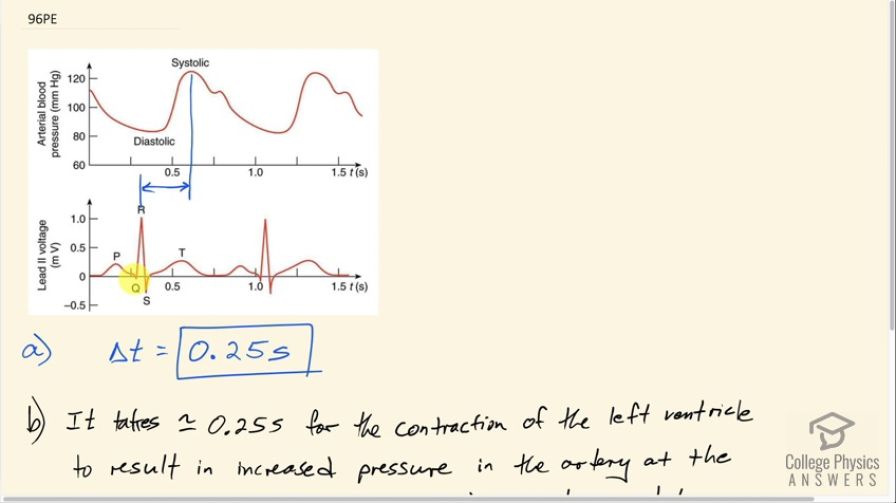Question
(a) Referring to Figure 20.34, find the time systolic pressure lags behind the middle of the QRS complex. (b) Discuss the reasons for the time lag.
Final Answer
- It takes about 0.25 seconds for the contraction of the left ventricle to result in increased pressure in the artery at the position where the pressure reading is being taken. Typically the pressure of the brachial artery is measured in the upper left arm. It takes 0.25 seconds for the pressure created by contraction of the left ventricle to propagate the distance from the heart to the upper arm.
Solution video
OpenStax College Physics for AP® Courses, Chapter 20, Problem 96 (Problems & Exercises)

vote with a rating of
votes with an average rating of
.
Video Transcript
This is College Physics Answers with Shaun Dychko. The QRS complex on this electrocardiogram indicates that the ventricles are depolarizing and then repolarizing— they are contracting, in other words— and we are asked to find out what is this time lag between the middle of the QRS complex and the time of the systolic blood pressure. So even though this systolic pressure occurs at a position that's in front of the middle of the QRS complex, this actually represents a time lag though because if we are reading from left to right, it would seem like the systolic maximum pressure is in front of the QRS complex but since this is a time axis, anything to the right is occurring later in time and so this is happening after this happened and so things that are positionally to the right are lagging things that are to the left. So this systolic pressure is lagging behind the QRS complex by about a quarter of a second because this is about the distance between two tick marks and each tick mark represents 0.25 seconds. So that's the answer to part (a) and part (b) asks what's the reason for the time lag? Well the QRS complex is when the ventricles are contracting but they take some time for that contraction to result in an increase in blood pressure wherever this pressure is being measured. So this is gonna be measuring traditionally an artery in the upper arm and that is some distance away from the heart and it takes time for this high pressure that the ventricles are creating at the heart to propagate through the arteries to the position of the measuring device in the upper arm. And there we go!